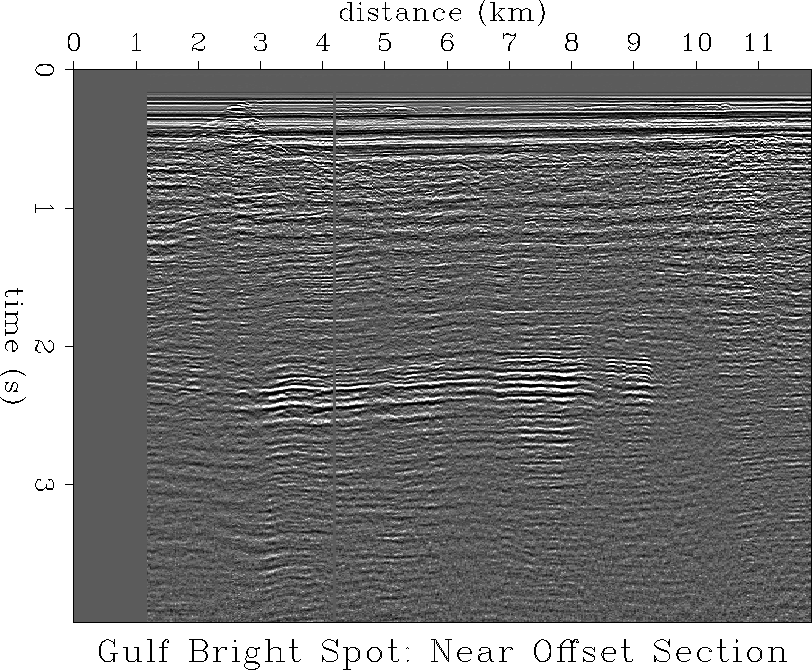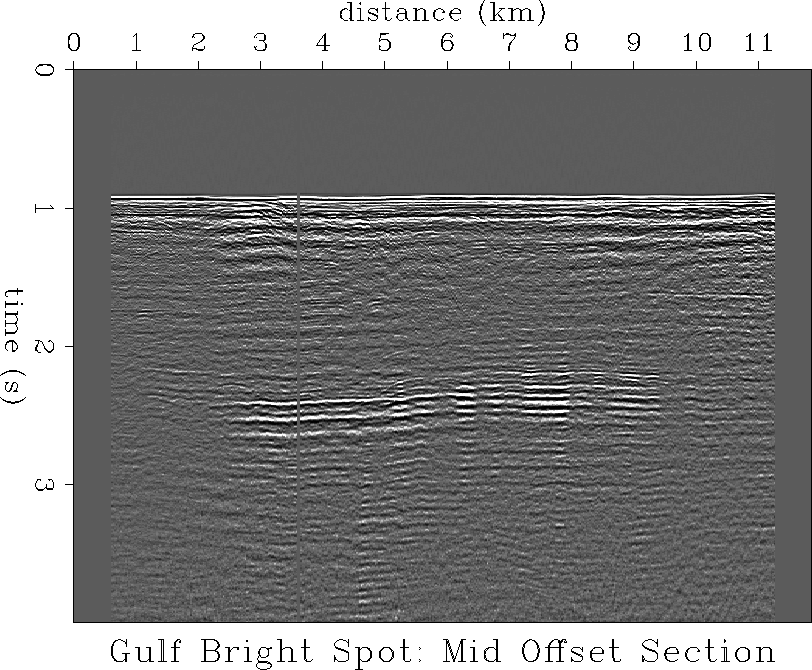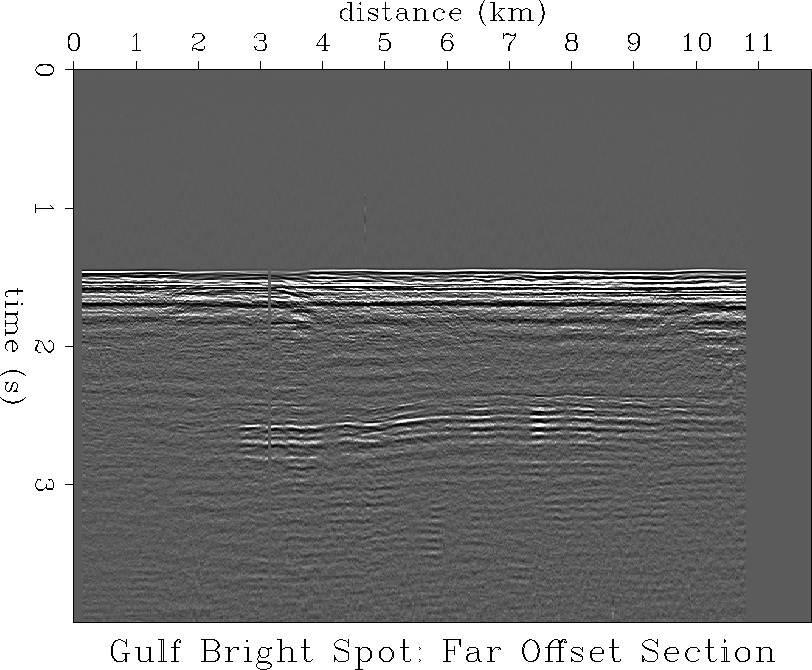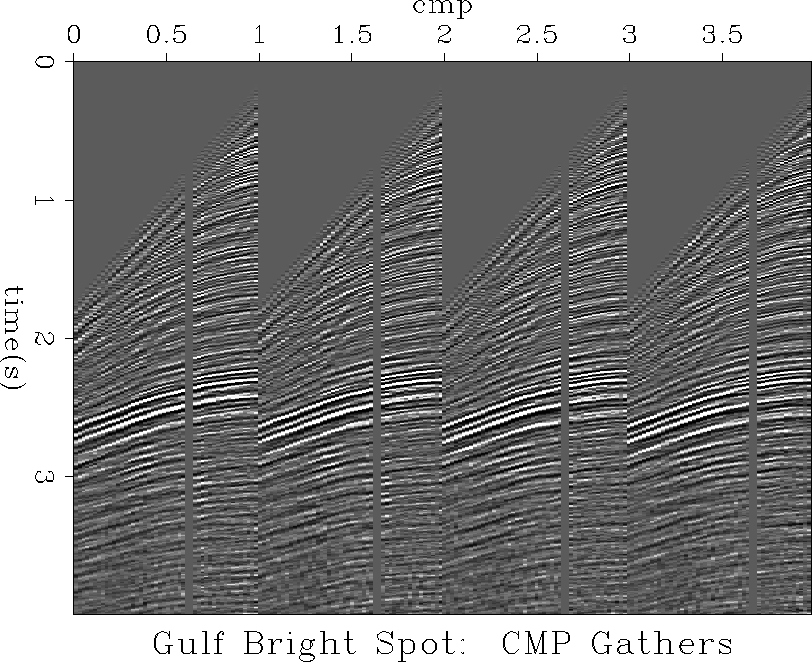




Next: Stacking velocity analysis
Up: Lumley: Reservoir velocity analysis
Previous: MIGRATION VELOCITY ANALYSIS
I now demonstrate the stacking velocity and migration velocity algorithms
on some CMP gathers recorded in the Gulf of Mexico. In addition, I
discuss cpu times and I/O behavior of the two algorithms with respect
to this marine data example.
Figure ![[*]](http://sepwww.stanford.edu/latex2html/cross_ref_motif.gif) is a near offset section displaying a bright spot in
the Gulf of Mexico. Figures
is a near offset section displaying a bright spot in
the Gulf of Mexico. Figures ![[*]](http://sepwww.stanford.edu/latex2html/cross_ref_motif.gif) and
and ![[*]](http://sepwww.stanford.edu/latex2html/cross_ref_motif.gif) are the mid and far offset
sections respectively. The offset distances are 241 m, 1391 m, and 2341 m.
These three constant offset sections are representative of hydrocarbon
reservoirs which exhibit spatially variable reservoir rock properties and/or
pore constituents. The lateral variation in relative P impedance in the
near offset section could be indicative of spatially variable gas content,
and in turn, variable porosity, for example. Of course, some spatial
amplitude variation is almost certainly due to near surface ``overburden''
focusing/defocusing effects, and would have to be compensated in any
amplitude inversion process. The three sections also indicate a general
AVO amplitude increase with offset, which is a common signature of HC gas.
A migration-inversion of these data could potentially better resolve the
spatial distribution of the reservoir properties which cause lateral
variations in seismic amplitude (Lumley and Beydoun, 1991, and Parsons, 1986).
are the mid and far offset
sections respectively. The offset distances are 241 m, 1391 m, and 2341 m.
These three constant offset sections are representative of hydrocarbon
reservoirs which exhibit spatially variable reservoir rock properties and/or
pore constituents. The lateral variation in relative P impedance in the
near offset section could be indicative of spatially variable gas content,
and in turn, variable porosity, for example. Of course, some spatial
amplitude variation is almost certainly due to near surface ``overburden''
focusing/defocusing effects, and would have to be compensated in any
amplitude inversion process. The three sections also indicate a general
AVO amplitude increase with offset, which is a common signature of HC gas.
A migration-inversion of these data could potentially better resolve the
spatial distribution of the reservoir properties which cause lateral
variations in seismic amplitude (Lumley and Beydoun, 1991, and Parsons, 1986).
near
Figure 1 Near offset section.
Constant offset is 241 m.
 mid
mid
Figure 2 Mid offset section.
Constant offset is 1391 m.
 far
far
Figure 3 Far offset section.
Constant offset is 2341 m.

Figure ![[*]](http://sepwww.stanford.edu/latex2html/cross_ref_motif.gif) shows four CMP gathers extracted from midpoints in the
4-5 km distance range of the common offset sections. The strong AVO effect
is readily visible in the gathers. Ideally, a high spatial resolution
velocity analysis at a fine CMP interval spacing across the section might
detect significant lateral variations in velocity. Given some in situ
well log/core measurements, it may be possible to correlate such
velocity variation to spatial variations of rock properties such as
pore gas/fluid content, porosity or clay content (Han, 1986).
shows four CMP gathers extracted from midpoints in the
4-5 km distance range of the common offset sections. The strong AVO effect
is readily visible in the gathers. Ideally, a high spatial resolution
velocity analysis at a fine CMP interval spacing across the section might
detect significant lateral variations in velocity. Given some in situ
well log/core measurements, it may be possible to correlate such
velocity variation to spatial variations of rock properties such as
pore gas/fluid content, porosity or clay content (Han, 1986).
cmps
Figure 4 Some representative CMP gathers.






Next: Stacking velocity analysis
Up: Lumley: Reservoir velocity analysis
Previous: MIGRATION VELOCITY ANALYSIS
Stanford Exploration Project
11/18/1997
![[*]](http://sepwww.stanford.edu/latex2html/cross_ref_motif.gif) is a near offset section displaying a bright spot in
the Gulf of Mexico. Figures
is a near offset section displaying a bright spot in
the Gulf of Mexico. Figures ![[*]](http://sepwww.stanford.edu/latex2html/cross_ref_motif.gif) and
and ![[*]](http://sepwww.stanford.edu/latex2html/cross_ref_motif.gif) are the mid and far offset
sections respectively. The offset distances are 241 m, 1391 m, and 2341 m.
These three constant offset sections are representative of hydrocarbon
reservoirs which exhibit spatially variable reservoir rock properties and/or
pore constituents. The lateral variation in relative P impedance in the
near offset section could be indicative of spatially variable gas content,
and in turn, variable porosity, for example. Of course, some spatial
amplitude variation is almost certainly due to near surface ``overburden''
focusing/defocusing effects, and would have to be compensated in any
amplitude inversion process. The three sections also indicate a general
AVO amplitude increase with offset, which is a common signature of HC gas.
A migration-inversion of these data could potentially better resolve the
spatial distribution of the reservoir properties which cause lateral
variations in seismic amplitude (Lumley and Beydoun, 1991, and Parsons, 1986).
are the mid and far offset
sections respectively. The offset distances are 241 m, 1391 m, and 2341 m.
These three constant offset sections are representative of hydrocarbon
reservoirs which exhibit spatially variable reservoir rock properties and/or
pore constituents. The lateral variation in relative P impedance in the
near offset section could be indicative of spatially variable gas content,
and in turn, variable porosity, for example. Of course, some spatial
amplitude variation is almost certainly due to near surface ``overburden''
focusing/defocusing effects, and would have to be compensated in any
amplitude inversion process. The three sections also indicate a general
AVO amplitude increase with offset, which is a common signature of HC gas.
A migration-inversion of these data could potentially better resolve the
spatial distribution of the reservoir properties which cause lateral
variations in seismic amplitude (Lumley and Beydoun, 1991, and Parsons, 1986).



